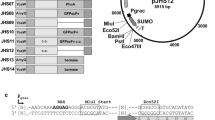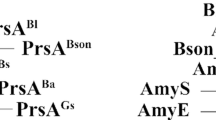Abstract
Recombinant proteins can be targeted to the Escherichia coli periplasm by fusing them to signal peptides. The popular pET vectors facilitate fusion of target proteins to the PelB signal. A systematic comparison of the PelB signal with native E. coli signal peptides for recombinant protein expression and periplasmic localization is not reported. We chose the Bacillus stearothermophilus maltogenic amylase (MA), an industrial enzyme widely used in the baking and brewing industry, as a model protein and analyzed the competence of seven, codon-optimized, E. coli signal sequences to translocate MA to the E. coli periplasm compared to PelB. MA fusions to three of the signals facilitated enhanced periplasmic localization of MA compared to the PelB fusion. Interestingly, these three fusions showed greatly improved MA yields and between 18- and 50-fold improved amylase activities compared to the PelB fusion. Previously, non-optimal codon usage in native E. coli signal peptide sequences has been reported to be important for protein stability and activity. Our results suggest that E. coli signal peptides with optimal codon usage could also be beneficial for heterologous protein secretion to the periplasm. Moreover, such fusions could even enhance activity rather than diminish it. This effect, to our knowledge has not been previously documented. In addition, the seven vector platform reported here could also be used as a screen to identify the best signal peptide partner for other recombinant targets of interest.




Similar content being viewed by others
References
Angelini S, Moreno R, Gouffi K, Santini C, Yamagishi A, Berenguer J, Wu L (2001) Export of Thermus thermophilus alkaline phosphatase via the twin-arginine translocation pathway in Escherichia coli. FEBS Lett 506:103–107
Baneyx F, Muhacic M (2004) Recombinant protein folding and misfolding in Escherichia coli. Nat Biotechnol 22:1399–1408
Cha HJ, Yoon HG, Kim YW, Lee HS, Kim JW, Kweon KS, Oh BH, Park KH (1998) Molecular and enzymatic characterization of a maltogenic amylase that hydrolyzes and transglycosylates acarbose. Eur J Biochem 253:251–262
Choi JH, Jeong KJ, Kim SC, Lee SY (2000) Efficient secretory production of alkaline phosphatase by high cell density culture of recombinant Escherichia coli using the Bacillus sp. endoxylanase signal sequence. Appl Microbiol Biotechnol 53:640–645
Choi JH, Lee SY (2004) Secretory and extracellular production of recombinant proteins using Escherichia coli. Appl Microbiol Biotechnol 64:625–635
Diderichsen et al. (1986) Preparation of a maltogenic amylase enzyme United States Patent 4598048
Fekkes P, Driessen AJ (1999) Protein targeting to the bacterial cytoplasmic membrane. Microbiol Mol Biol Rev 63:161–173
Georgiou G, Segatori L (2005) Preparative expression of secreted proteins in bacteria: status report and future prospects. Curr Opin Biotechnol 5:538–545
Gold L (1990) Expression of heterologous proteins in Escherichia coli. Method Enzymol 185:11–14
Izard JW, Kendall DA (1994) Signal peptides: exquisitely designed transport promoters. Mol Microbiol 13:765–773
Lee SY, Jeong KJ (2006) US20067070989B2
Makrides SC (1996) Strategies for achieving high-level expression of genes in Escherichia coli. Microbiol Rev 60:512–538
Marino MH (1989) Expression systems for heterologous protein production. BioPharmacology 2:18–33
Mergulhão FJ, Summers DK, Monteiro GA (2005) Recombinant protein secretion in Escherichia coli. Biotechnol Adv 23:177–202
Olins PO, Lee SC (1993) Recent advances in heterologous gene expression in Escherichia coli. Curr Opin Biotechnol 4:520–525
Pugsley AP (1993) The complete general secretory pathway in gram-negative bacteria. Microbiol Rev 57:50–108
Qian ZG, Xia XX, Choi JH, Lee SY (2008) Proteome-based identification of fusion partner for high-level extracellular production of recombinant proteins in Escherichia coli. Biotechnol Bioeng 101:587–601
Rouet R, Lowe D, Dudgeon K, Roome B, Schofield P, Langley D, Andrews J, Whitfeld P, Jermutus L, Christ D (2012) Expression of high-affinity human antibody fragments in bacteria. Nat Protoc 7:364–373
Sargent F, Gohlke U, de Leeuw E, Stanley NR, Palmer T, Saibil HR, Berks BC (2001) Purified components of the Escherichia coli Tat protein transport system form a double layered ring structure. Eur J Biochem 268:3361–3367
Shokri A, Sanden AM, Larsson G (2003) Cell and process design for targeting of recombinant protein. Appl Microbiol Biotechnol 60:654–664
Singh P, Sharma L, Kulothangan RS, Adkar BV, Prajapati RS et al (2013) Effect of signal peptide on stability and folding of Escherichia coli thioredoxin. PLoS ONE 8(5):e63442
Stuart RA, Neupert W (2000) Making membranes in bacteria. Nature 406:575–577
Valent QA, Scotti PA, High S, de Gier JW, von Hejine G, Lentzen G, Wintermeyer W, Oudega B, Luirink J (1998) The Escherichia coli SRP and SecB targeting pathways converge at the translocon. EMBO J 17(9):2504–2512
Zalucki YM, Beachem IR, Jennings MP (2009) Biased codon usage in signal peptides: a role in protein export. Trends Microbiol 17:146–150
Zalucki YM, Jones CE, Ng PS, Schulz BL, Jennings MP (2010) Signal sequence non-optimal codons are required for the correct folding of mature maltose binding protein. Biochem Biophys Acta 1798:1244–1249
Zalucki YM, Shafer WM, Jennings MP (2011) Directed evolution of efficient secretion in the SRP-dependent export of TolB. Biochem Biophys Acta 1808:2544–2550
Author information
Authors and Affiliations
Corresponding author
Rights and permissions
About this article
Cite this article
Samant, S., Gupta, G., Karthikeyan, S. et al. Effect of codon-optimized E. coli signal peptides on recombinant Bacillus stearothermophilus maltogenic amylase periplasmic localization, yield and activity. J Ind Microbiol Biotechnol 41, 1435–1442 (2014). https://doi.org/10.1007/s10295-014-1482-8
Received:
Accepted:
Published:
Issue Date:
DOI: https://doi.org/10.1007/s10295-014-1482-8




